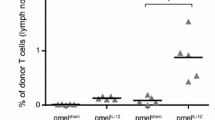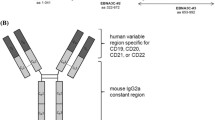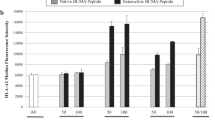Abstract
We investigated to establish CD40-activated B cells (CD40-B cells) as alternative antigen-presenting cells (APCs) for the induction of myeloma-specific cytotoxic T lymphocytes (CTLs). To generate CD40-B cells, peripheral blood mononuclear cells were co-cultured with CD40L-transfected J558 cells in the presence of IL-4, insulin, transferrin, and cyclosporine for 14 days, and pulsed with myeloma lysates. The CD40-B cells consistently expressed high levels of CD80, CD86, CD54, CCR7, and HLA-DR. The CD40-B cells produced IL-12, IFN-γ, and IL-6 during the culture period, but not IL-10. In addition, the CD40-B cells showed potent allogeneic T-cell stimulatory capacities that depended on the dose ratio and had the potential to polarize naïve T cells into Th1 subsets. The CD40-B cells loaded with tumor lysates induced strong target-specific CTLs, based on large numbers of IFN-γ secreting cells and higher cytotoxic activity against target cells compared to the CD40-B cells without the tumor lysates. These results suggest that CD40-B cells loaded with myeloma lysates might provide alternative APCs for cellular immunotherapy in patients with myeloma.




Similar content being viewed by others
References
Kyle RA, Rajkumar SV (2004) Multiple myeloma. N Engl J Med 351(18):1860–1873. doi:10.1056/NEJMra041875
Harrison SJ, Cook G (2005) Immunotherapy in multiple myeloma—possibility or probability? Br J Haematol 130(3):344–362. doi:10.1111/j.1365–2141.2005.05534.x
Lee JJ, Choi BH, Kang HK, Park MS, Park JS, Kim SK, Pham TN, Cho D, Nam JH, Kim YJ, Rhee JH, Yang DH, Kim YK, Kim HJ, Chung IJ (2007) Induction of multiple myeloma-specific cytotoxic T lymphocyte stimulation by dendritic cell pulsing with purified and optimized myeloma cell lysates. Leuk Lymphoma 48(10):2022–2031
Curti A, Tosi P, Comoli P, Terragna C, Ferri E, Cellini C, Massaia M, D’Addio A, Giudice V, Di Bello C, Cavo M, Conte R, Gugliotta G, Baccarani M, Lemoli RM (2007) Phase I/II clinical trial of sequential subcutaneous and intravenous delivery of dendritic cell vaccination for refractory multiple myeloma using patient-specific tumour idiotype protein or idiotype (VDJ)-derived class I-restricted peptides. Br J Haematol 139(3):415–424
Guardino AE, Rajapaksa R, Ong KH, Sheehan K, Levy R (2006) Production of myeloid dendritic cells (DC) pulsed with tumor-specific idiotype protein for vaccination of patients with multiple myeloma. Cytotherapy 8(3):277–289. doi:10.1080/14653240600735701
Reichardt VL, Brossart P (2005) Dendritic cells in clinical trials for multiple myeloma. Methods Mol Med 109:127–136
Figdor CG, de Vries IJ, Lesterhuis WJ, Melief CJ (2004) Dendritic cell immunotherapy: mapping the way. Nat Med 10(5):475–480. doi:10.1038/nm1039
Wen YJ, Min R, Tricot G, Barlogie B, Yi Q (2002) Tumor lysate-specific cytotoxic T lymphocytes in multiple myeloma: promising effector cells for immunotherapy. Blood 99(9):3280–3285. doi:10.1182/blood.V99.9.3280
Schultze JL, Grabbe S, von Bergwelt-Baildon MS (2004) DCs and CD40-activated B cells: current and future avenues to cellular cancer immunotherapy. Trends Immunol 25(12):659–664. doi:10.1016/j.it.2004.09.016
Banchereau J, Steinman RM (1998) Dendritic cells and the control of immunity. Nature 392(6673):245–252. doi:10.1038/32588
Reid DC (2001) Dendritic cells and immunotherapy for malignant disease. Br J Haematol 112(4):874–887. doi:10.1046/j.1365-2141.2001.02626.x
Romani N, Gruner S, Brang D, Kampgen E, Lenz A, Trockenbacher B, Konwalinka G, Fritsch PO, Steinman RM, Schuler G (1994) Proliferating dendritic cell progenitors in human blood. J Exp Med 180(1):83–93. doi:10.1084/jem.180.1.83
Romani N, Reider D, Heuer M, Ebner S, Kampgen E, Eibl B, Niederwieser D, Schuler G (1996) Generation of mature dendritic cells from human blood. An improved method with special regard to clinical applicability. J Immunol Methods 196(2):137–151. doi:10.1016/0022-1759(96)00078-6
Bender A, Sapp M, Schuler G, Steinman RM, Bhardwaj N (1996) Improved methods for the generation of dendritic cells from nonproliferating progenitors in human blood. J Immunol Methods 196(2):121–135. doi:10.1016/0022-1759(96)00079-8
Finkelman FD, Lees A, Birnbaum R, Gause WC, Morris SC (1996) Dendritic cells can present antigen in vivo in a tolerogenic or immunogenic fashion. J Immunol 157(4):1406–1414
Ardeshna KM, Pizzey AR, Thomas NS, Orr S, Linch DC, Devereux S (2000) Monocyte-derived dendritic cells do not proliferate and are not susceptible to retroviral transduction. Br J Haematol 108(4):817–824. doi:10.1046/j.1365-2141.2000.01956.x
MartIn-Fontecha A, Sebastiani S, Hopken UE, Uguccioni M, Lipp M, Lanzavecchia A, Sallusto F (2003) Regulation of dendritic cell migration to the draining lymph node: impact on T lymphocyte traffic and priming. J Exp Med 198(4):615–621. doi:10.1084/jem.20030448
Paulie S, Ehlin-Henriksson B, Mellstedt H, Koho H, Ben-Aissa H, Perlmann P (1985) A p50 surface antigen restricted to human urinary bladder carcinomas and B lymphocytes. Cancer Immunol Immunother 20(1):23–28. doi:10.1007/BF00199769
Stamenkovic I, Clark EA, Seed B (1989) A B-lymphocyte activation molecule related to the nerve growth factor receptor and induced by cytokines in carcinomas. EMBO J 8(5):1403–1410
Koho H, Paulie S, Ben-Aissa H, Jonsdottir I, Hansson Y, Lundblad ML, Perlmann P (1984) Monoclonal antibodies to antigens associated with transitional cell carcinoma of the human urinary bladder. I. Determination of the selectivity of six antibodies by cell ELISA and immunofluorescence. Cancer Immunol Immunother 17(3):165–172. doi:10.1007/BF00205481
von Bergwelt-Baildon M, Maecker B, Schultze J, Gribben JG (2004) CD40 activation: potential for specific immunotherapy in B-CLL. Ann Oncol 15(6):853–857. doi:10.1093/annonc/mdh213
Grewal IS, Flavell RA (1996) The role of CD40 ligand in costimulation and T-cell activation. Immunol Rev 153:85–106. doi:10.1111/j.1600-065X.1996.tb00921.x
Rathmell JC, Townsend SE, Xu JC, Flavell RA, Goodnow CC (1996) Expansion or elimination of B cells in vivo: dual roles for CD40- and Fas (CD95)-ligands modulated by the B cell antigen receptor. Cell 87(2):319–329. doi:10.1016/S0092-8674(00)81349-5
Lee JJ, Takei M, Hori S, Inoue Y, Harada Y, Tanosaki R, Kanda Y, Kami M, Makimoto A, Mineishi S, Kawai H, Shimosaka A, Heike Y, Ikarashi Y, Wakasugi H, Takaue Y, Hwang TJ, Kim HJ, Kakizoe T (2002) The role of PGE(2) in the differentiation of dendritic cells: how do dendritic cells influence T-cell polarization and chemokine receptor expression? Stem Cells 20(5):448–459. doi:10.1634/stemcells.20-5-448
Lee JJ, Park MS, Park JS, Kang HK, Kim SK, Nguyen Pham TN, Zhu XW, Cho D, Nam JH, Kim YJ, Rhee JH, Chung IJ, Kim HJ (2006) Induction of leukemic-cell-specific cytotoxic T lymphocytes by autologous monocyte-derived dendritic cells presenting leukemic cell antigens. J Clin Apher 21(3):188–194. doi:10.1002/jca.20085
Schultze JL, Michalak S, Seamon MJ, Dranoff G, Jung K, Daley J, Delgado JC, Gribben JG, Nadler LM (1997) CD40-activated human B cells: an alternative source of highly efficient antigen presenting cells to generate autologous antigen-specific T cells for adoptive immunotherapy. J Clin Invest 100(11):2757–2765. doi:10.1172/JCI119822
von Bergwelt-Baildon MS, Vonderheide RH, Maecker B, Hirano N, Anderson KS, Butler MO, Xia Z, Zeng WY, Wucherpfennig KW, Nadler LM, Schultze JL (2002) Human primary and memory cytotoxic T lymphocyte responses are efficiently induced by means of CD40-activated B cells as antigen-presenting cells: potential for clinical application. Blood 99(9):3319–3325. doi:10.1182/blood.V99.9.3319
Kondo E, Topp MS, Kiem HP, Obata Y, Morishima Y, Kuzushima K, Tanimoto M, Harada M, Takahashi T, Akatsuka Y (2002) Efficient generation of antigen-specific cytotoxic T cells using retrovirally transduced CD40-activated B cells. J Immunol 169(4):2164–2171
Lapointe R, Bellemare-Pelletier A, Housseau F, Thibodeau J, Hwu P (2003) CD40-stimulated B lymphocytes pulsed with tumor antigens are effective antigen-presenting cells that can generate specific T cells. Cancer Res 63(11):2836–2843
Lee J, Dollins CM, Boczkowski D, Sullenger BA, Nair S (2008) Activated B cells modified by electroporation of multiple mRNAs encoding immune stimulatory molecules are comparable to mature dendritic cells in inducing in vitro antigen-specific T-cell responses. Immunology 125(2):229–240. doi:10.1111/j.1365-2567.2008.02833.x
Inoue S, Leitner WW, Golding B, Scott D (2006) Inhibitory effects of B cells on antitumor immunity. Cancer Res 66(15):7741–7747. doi:10.1158/0008-5472.CAN-05-3766
Barr TA, Brown S, Ryan G, Zhao J, Gray D (2007) TLR-mediated stimulation of APC: Distinct cytokine responses of B cells and dendritic cells. Eur J Immunol 37(11):3040–3053. doi:10.1002/eji.200636483
Fanslow WC, Srinivasan S, Paxton R, Gibson MG, Spriggs MK, Armitage RJ (1994) Structural characteristics of CD40 ligand that determine biological function. Semin Immunol 6(5):267–278. doi:10.1006/smim.1994.1035
Baccam M, Bishop GA (1999) Membrane-bound CD154, but not CD40-specific antibody, mediates NF-kappaB-independent IL-6 production in B cells. Eur J Immunol 29(12):3855–3866. doi:10.1002/(SICI)1521-4141(199912)29:12<3855::AID-IMMU3855>3.0.CO;2-S
Neron S, Racine C, Roy A, Guerin M (2005) Differential responses of human B-lymphocyte subpopulations to graded levels of CD40–CD154 interaction. Immunology 116(4):454–463
Fecteau JF, Neron S (2003) CD40 stimulation of human peripheral B lymphocytes: distinct response from naive and memory cells. J Immunol 171(9):4621–4629
Mathur RK, Awasthi A, Wadhone P, Ramanamurthy B, Saha B (2004) Reciprocal CD40 signals through p38MAPK and ERK-1/2 induce counteracting immune responses. Nat Med 10(5):540–544. doi:10.1038/nm1045
Luft T, Maraskovsky E, Schnurr M, Knebel K, Kirsch M, Gorner M, Skoda R, Ho AD, Nawroth P, Bierhaus A (2004) Tuning the volume of the immune response: strength and persistence of stimulation determine migration and cytokine secretion of dendritic cells. Blood 104(4):1066–1074. doi:10.1182/blood-2003-12-4146
Schultze JL, Michalak S, Lowne J, Wong A, Gilleece MH, Gribben JG, Nadler LM (1999) Human non-germinal center B cell interleukin (IL)-12 production is primarily regulated by T cell signals CD40 ligand, interferon gamma, and IL-10: role of B cells in the maintenance of T cell responses. J Exp Med 189(1):1–12. doi:10.1084/jem.189.1.1
von Bergwelt-Baildon M, Shimabukuro-Vornhagen A, Popov A, Klein-Gonzalez N, Fiore F, Debey S, Draube A, Maecker B, Menezes I, Nadler LM, Schultze JL (2006) CD40-activated B cells express full lymph node homing triad and induce T-cell chemotaxis: potential as cellular adjuvants. Blood 107(7):2786–2789. doi:10.1182/blood-2004-01-0113
Rodriguez-Pinto D, Moreno J (2005) B cells can prime naive CD4+ T cells in vivo in the absence of other professional antigen-presenting cells in a CD154–CD40-dependent manner. Eur J Immunol 35(4):1097–1105. doi:10.1002/eji.200425732
Ritchie DS, Yang J, Hermans IF, Ronchese F (2004) B-Lymphocytes activated by CD40 ligand induce an antigen-specific anti-tumour immune response by direct and indirect activation of CD8(+) T-cells. Scand J Immunol 60(6):543–551. doi:10.1111/j.0300-9475.2004.01517.x
Acknowledgements
This research was supported by grant no. RTI05-01-01 from the Regional Technology Innovation Program of the Ministry of Commerce, Industry and Energy (MOCIE), Republic of Korea, and by a grant of the Korea Healthcare technology R&D Project, Ministry of Health & Welfare, Republic of Korea (A080489).
Author information
Authors and Affiliations
Corresponding author
Additional information
Sang-Ki Kim and Thanh-Nhan Nguyen Pham equally contributed to this work.
Rights and permissions
About this article
Cite this article
Kim, SK., Nguyen Pham, TN., Nguyen Hoang, T.M. et al. Induction of myeloma-specific cytotoxic T lymphocytes ex vivo by CD40-activated B cells loaded with myeloma tumor antigens. Ann Hematol 88, 1113–1123 (2009). https://doi.org/10.1007/s00277-009-0721-y
Received:
Accepted:
Published:
Issue Date:
DOI: https://doi.org/10.1007/s00277-009-0721-y




